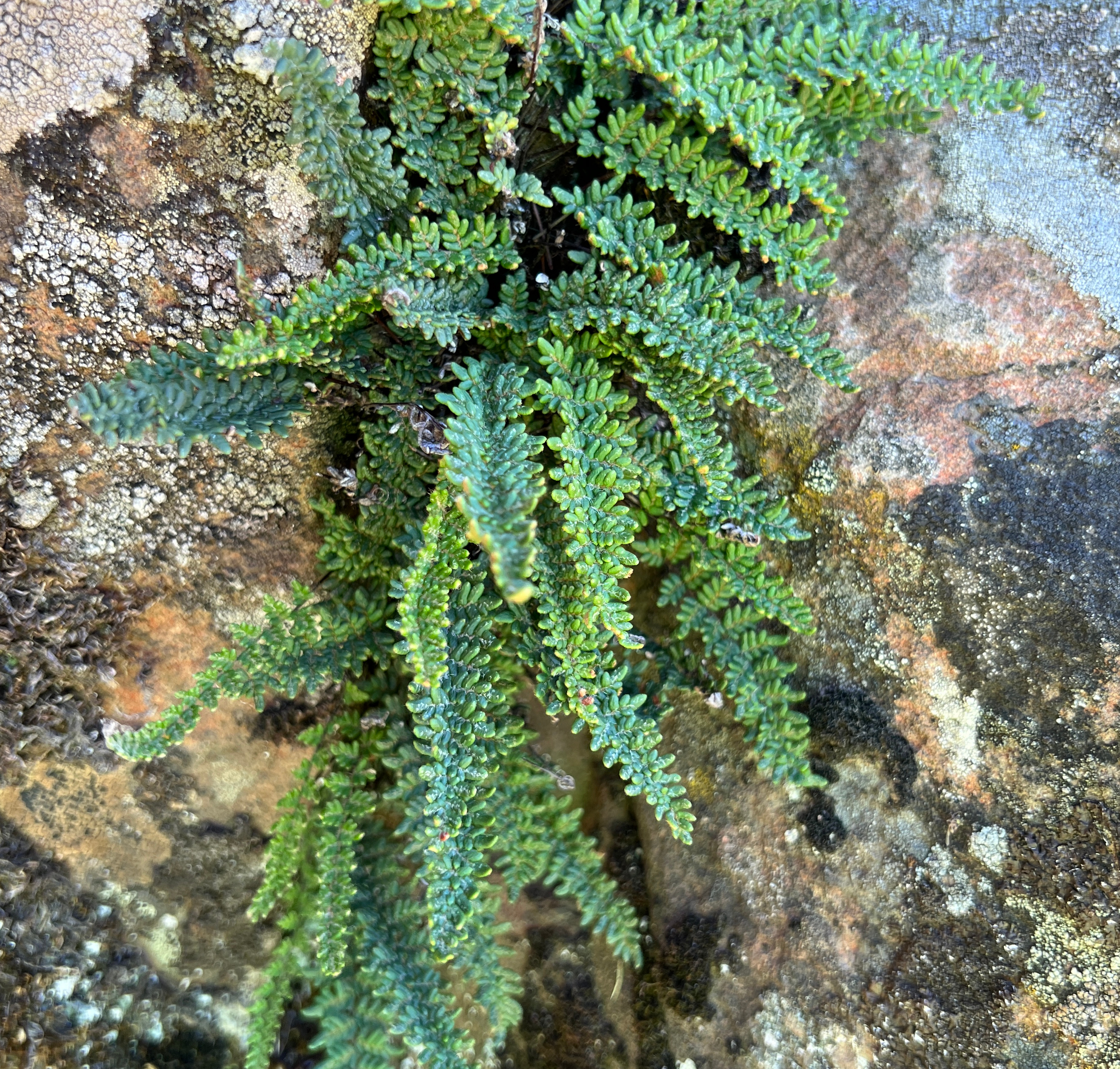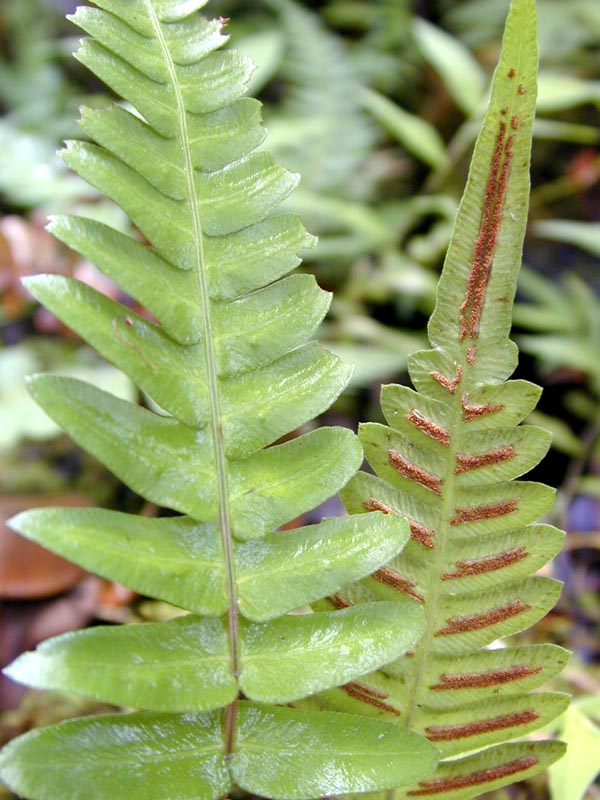|
Myriopteris Allosuroides
''Myriopteris allosuroides'' is a moderately-sized fern of Mexico, a member of the family Pteridaceae. Unlike many members of its genus, its rachides are grooved on the upper surface and largely free of hairs or scales. One of the cheilanthoid ferns, it was usually classified in the genera ''Cheilanthes'' or '' Pellaea'' until 2013, when the genus ''Myriopteris'' was again recognized as separate from ''Cheilanthes''. It typically grows on dry, rocky slopes over acidic, particularly basaltic, rock. Description Leaf bases are closely spaced along the rhizome, which is in diameter. The rhizome bears scales, which are linear with entire (untoothed) margins. They are of a uniform orange-brown color, and measure long. The fronds spring up in clusters; they do not unfold as fiddleheads like typical ferns (noncircinate vernation). When mature, they are up to long. The stipe (the stalk of the leaf, below the blade) represents about one-third of the total length of the leaf. The u ... [...More Info...] [...Related Items...] OR: [Wikipedia] [Google] [Baidu] |
Georg Heinrich Mettenius
Georg Heinrich Mettenius (24 November 1823 – 18 August 1866) was a German botanist born in Frankfurt am Main. He was son-in-law to botanist Alexander Braun (1805–1877). In 1845 he received his medical doctorate from the University of Heidelberg. After graduation, he studied marine algae in Helgoland and Fiume. In 1848 he returned to Heidelberg as a privat-docent, and was later appointed an associate professor of botany at Freiburg. In 1852 he became a full professor at the University of Leipzig as well as director of its botanical garden. He died of cholera in Leipzig at the age of 42. Mettenius was a leading authority in the field of pteridology. The plant genus '' Metteniusa'' (family Metteniusaceae) is named in his honor. Selected publications * ''Beiträge zur Kenntniss der Rhizocarpeen'' (1846) - Contributions to the knowledge of Rhizocarpaceae. * "Filices horti botanici Lipsiensis" (1856) * "Filices Lechlerianae Chilenses ac Peruanae cura" (1856). * ''Über einig ... [...More Info...] [...Related Items...] OR: [Wikipedia] [Google] [Baidu] |
Rhizome
In botany and dendrology, a rhizome (; , ) is a modified subterranean plant stem that sends out roots and shoots from its nodes. Rhizomes are also called creeping rootstalks or just rootstalks. Rhizomes develop from axillary buds and grow horizontally. The rhizome also retains the ability to allow new shoots to grow upwards. A rhizome is the main stem of the plant that runs underground horizontally. A stolon is similar to a rhizome, but a stolon sprouts from an existing stem, has long internodes, and generates new shoots at the end, such as in the strawberry plant. In general, rhizomes have short internodes, send out roots from the bottom of the nodes, and generate new upward-growing shoots from the top of the nodes. A stem tuber is a thickened part of a rhizome or stolon that has been enlarged for use as a storage organ. In general, a tuber is high in starch, e.g. the potato, which is a modified stolon. The term "tuber" is often used imprecisely and is sometimes appli ... [...More Info...] [...Related Items...] OR: [Wikipedia] [Google] [Baidu] |
Myriopteris Notholaenoides
''Myriopteris'', commonly known as the lip ferns, is a genus of cheilanthoid ferns. Like other cheilanthoids, they are ferns of dry habitats, reproducing both sexually and apogamously. Many species have leaves divided into a large number of small, bead-like segments, the probable inspiration for the generic name. Hairs and/or scales are often present on both the upper and lower surfaces of the leaf, and their presence and appearance are useful in distinguishing between species. The genus is most diverse in Mexico, but species are found from southwestern Canada south to southern Chile, and one species is endemic to southern Africa. Description No single morphological character divides ''Myriopteris'', as presently circumscribed, from the other cheilanthoids. Convergent evolution in arid environments is thought to be responsible for widespread homoplasy in the morphological characters traditionally used to classify this group. While small, bead-like ultimate segments are associat ... [...More Info...] [...Related Items...] OR: [Wikipedia] [Google] [Baidu] |
Congener (biology)
Biological specificity is the tendency of a characteristic such as a behavior or a biochemical variation to occur in a particular species. Biochemist Linus Pauling stated that "Biological specificity is the set of characteristics of living organisms or constituents of living organisms of being special or doing something special. Each animal or plant species is special. It differs in some way from all other species...biological specificity is the major problem about understanding life." Biological specificity within ''Homo sapiens'' ''Homo sapiens'' has many characteristics that show the biological specificity in the form of behavior and morphological traits. Morphologically, humans have an enlarged cranial capacity and more gracile features in comparison to other hominins. The reduction of dentition is a feature that allows for the advantage of adaptability in diet and survival. As a species, humans are culture dependent and much of human survival relies on the culture and so ... [...More Info...] [...Related Items...] OR: [Wikipedia] [Google] [Baidu] |
Vein (botany)
A leaf ( : leaves) is any of the principal appendages of a vascular plant stem, usually borne laterally aboveground and specialized for photosynthesis. Leaves are collectively called foliage, as in "autumn foliage", while the leaves, stem, flower, and fruit collectively form the shoot system. In most leaves, the primary photosynthetic tissue is the palisade mesophyll and is located on the upper side of the blade or lamina of the leaf but in some species, including the mature foliage of ''Eucalyptus'', palisade mesophyll is present on both sides and the leaves are said to be isobilateral. Most leaves are flattened and have distinct upper ( adaxial) and lower ( abaxial) surfaces that differ in color, hairiness, the number of stomata (pores that intake and output gases), the amount and structure of epicuticular wax and other features. Leaves are mostly green in color due to the presence of a compound called chlorophyll that is essential for photosynthesis as it absorbs light ... [...More Info...] [...Related Items...] OR: [Wikipedia] [Google] [Baidu] |
Indusium
A sorus (pl. sori) is a cluster of sporangia (structures producing and containing spores) in ferns and fungi. A coenosorus (plural coenosori) is a compound sorus composed of multiple, fused sori. Etymology This New Latin word is from Ancient Greek σωρός (''sōrós'' 'stack, pile, heap'). Structure In lichens and other fungi, the sorus is surrounded by an external layer. In some red algae, it may take the form of depression into the thallus. In ferns, the sori form a yellowish or brownish mass on the edge or underside of a fertile frond. In some species, they are protected during development by a scale or film of tissue called the indusium, which forms an umbrella-like cover. Lifecycle significance Sori occur on the sporophyte generation, the sporangia within producing haploid meiospores. As the sporangia mature, the indusium shrivels so that spore release is unimpeded. The sporangia then burst and release the spores. As an aid to identification The shape, arrangemen ... [...More Info...] [...Related Items...] OR: [Wikipedia] [Google] [Baidu] |
Sorus
A sorus (pl. sori) is a cluster of sporangia (structures producing and containing spores) in ferns and fungi. A coenosorus (plural coenosori) is a compound sorus composed of multiple, fused sori. Etymology This New Latin word is from Ancient Greek σωρός (''sōrós'' 'stack, pile, heap'). Structure In lichens and other fungi, the sorus is surrounded by an external layer. In some red algae, it may take the form of depression into the thallus. In ferns, the sori form a yellowish or brownish mass on the edge or underside of a fertile frond. In some species, they are protected during development by a scale or film of tissue called the indusium, which forms an umbrella-like cover. Lifecycle significance Sori occur on the sporophyte generation, the sporangia within producing haploid meiospores. As the sporangia mature, the indusium shrivels so that spore release is unimpeded. The sporangia then burst and release the spores. As an aid to identification The shape, arrangem ... [...More Info...] [...Related Items...] OR: [Wikipedia] [Google] [Baidu] |
Costa (botany)
This glossary of botanical terms is a list of definitions of terms and concepts relevant to botany and plants in general. Terms of plant morphology are included here as well as at the more specific Glossary of plant morphology and Glossary of leaf morphology. For other related terms, see Glossary of phytopathology, Glossary of lichen terms, and List of Latin and Greek words commonly used in systematic names. A B ... [...More Info...] [...Related Items...] OR: [Wikipedia] [Google] [Baidu] |
Auricle (botany)
In botany, an auricle is a small ear-like projection from the base of a leaf or petal Petals are modified leaves that surround the reproductive parts of flowers. They are often brightly colored or unusually shaped to attract pollinators. All of the petals of a flower are collectively known as the ''corolla''. Petals are usuall .... ReferencesDictionary of Botany Plant morphology {{botany-stub ... [...More Info...] [...Related Items...] OR: [Wikipedia] [Google] [Baidu] |
Pinnation
Pinnation (also called pennation) is the arrangement of feather-like or multi-divided features arising from both sides of a common axis. Pinnation occurs in biological morphology, in crystals, such as some forms of ice or metal crystals, and in patterns of erosion or stream beds. The term derives from the Latin word ''pinna'' meaning "feather", "wing", or " fin". A similar concept is "pectination," which is a comb-like arrangement of parts (arising from one side of an axis only). Pinnation is commonly referred to in contrast to "palmation," in which the parts or structures radiate out from a common point. The terms "pinnation" and "pennation" are cognate, and although they are sometimes used distinctly, there is no consistent difference in the meaning or usage of the two words.Jackson, Benjamin, Daydon; A Glossary of Botanic Terms with their Derivation and Accent; Published by Gerald Duckworth & Co. London, 4th ed 1928 Plants Botanically, pinnation is an arrangement of ... [...More Info...] [...Related Items...] OR: [Wikipedia] [Google] [Baidu] |
Stipe (botany)
In botany, a stipe is a stalk that supports some other structure. The precise meaning is different depending on which taxonomic group is being described. file:Helicteres-Yucatán-Flowers.jpg, The long stipe of a '' Helicteres'' flower. file:Helicteres-Yucatán-Fruits.jpg, remains as each flower forms a fruit. In the case of ferns, the stipe is only the petiole from the rootstock to the beginning of the leaf tissue, or lamina. The continuation of the structure within the lamina is then termed a rachis. In flowering plants, the term is often used in reference to a stalk that sometimes supports a flower's ovary. In orchids, the stipe or caudicle is the stalk-like support of the pollinia. It is a non-viscid band or strap connecting the pollinia with the viscidium (the viscid part of the rostellum or beak). A stipe is also a structure found in organisms that are studied by botanists but that are no longer classified as plants. It may be the stem-like part of the thallus o ... [...More Info...] [...Related Items...] OR: [Wikipedia] [Google] [Baidu] |



.png)


